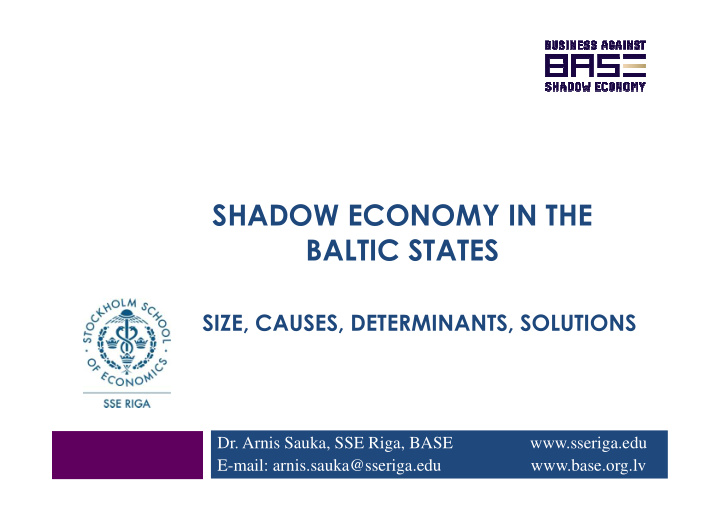



SHADOW ECONOMY IN THE BALTIC STATES SIZE, CAUSES, DETERMINANTS, SOLUTIONS Dr. Arnis Sauka, SSE Riga, BASE www.sseriga.edu E-mail: arnis.sauka@sseriga.edu www.base.org.lv
DEFINITION
What is ‘shadow economy’? Observed and non-observed components of GDP (Putnins and Sauka, 2015)
SIZE
F. Schneider (2016) estimates The identified challenges and solutions as suggested by the construction industry strongly indicate that: It is crucial to allocate appropriate resources in order to • plan, implement and measure the results of activities to fight the shadow economy! Various ministries (Economics, Finance, Education, • Welfare, Justice) should be involved in fighting the shadow economy! Coordination – mastery! • Communication with industries! •
Putnins, T. and A. Sauka (2016) estimates
CAUSES
Rational choice Benefits of not paying taxes compared to the risk of being caught evading taxes and the cost of the consequent punishment. Tax evasion is much lower than can be explained by expected utility in financial terms alone!
Tax morale Tax morale – a moral obligation to pay taxes and “a belief in contributing to society by paying taxes” (Torgler and Schneider 2009: 230) Source: Mickiewicz, Rebmann and Sauka (2017), drawing on Scott (2014).
DETERMINANTS
Components of the shadow economy in the Baltic countries, 2015 Source: Putnins and Sauka, 2016.
Envelope wages (average share of salaries in % which is paid by employers but concealed from the government) in the Baltic countries Source: Putnins and Sauka, 2016.
Underreporting of business income (average share of revenue in % that companies conceal from the government) in the Baltic countries Source: Putnins and Sauka, 2016.
INFLUENTIAL FACTORS/ TRENDS
Satisfaction with the State Revenue Service, 2010-2015 Source: Putnins and Sauka, 2016.
Satisfaction with the government’s tax policy, 2010-2015 Source: Putnins and Sauka, 2016.
Satisfaction with the quality of business legislation, 2010-2015 Source: Putnins and Sauka, 2016.
Satisfaction with the government’s support for entrepreneurs, 2010-2015 Source: Putnins and Sauka, 2016.
Probability of being caught for underreporting business income, 2015 Source: Putnins and Sauka, 2016.
Consequences of being caught for deliberate misreporting, 2015 Source: Putnins and Sauka, 2016.
POLICY SUGGESTIONS
Framework for planning and measuring policy incentives to decrease the shadow economy Challenge 1a: high labour taxes. Activity (i): to decrease labour taxes… Determinant 1: Envelope wages. Activity (ii): … Measure : average total, average Activity (iii) … industries (various sources): Measures , i, ii, iii … changes 2016 vs 2015 Challenge 1b… Challenge 1c… Challenge 2a: VAT schemes. Determinant 2: Unreported Shadow economy (size) , Activity (i): income. % of GDP -> EUR Activity (ii): … Measure : average total, average Measure : various sources, Activity (iii) … industries (various sources): changes 2016 as compared Measures i, ii, iii … changes 2016 vs 2015 to 2015 Challenge 2b: re-invested profits issue … Determinant 3: Underreported employees Measure : … Determinant 4: Tax morale Measure: …
Is the shadow economy always “unproductive”? short and long term perspective Venture level outcome - + Quadrant I Quadrant II + Hero or success Catalyst enterprises enterprises (productive?) Societal level (productive) outcome Quadrant IV Quadrant III - Failed enterprises Robber or re- distributive enterprises (always (unproductive?) unproductive?) Source: Sauka (2008), Davidsson (2004)
Institutional features of any economic system (i.e. ‘context’) determine what entrepreneurs can do and find profitable to do (Baumol, 1990) Most companies are actually involved in both productive and rent seeking activities at the same time (Rehn and Taalas, 2004; Scase, 2003). Structure of payoffs in an economy can also render unproductive activities more profitable than productive activities. … Allocation of resources to either productive or unproductive use varies across societies (Baumol, 1990).
Some recent studies exploring the shadow economy in the Baltic states Putnins, T. and A. Sauka (2016) The shadow economy index for the Baltic countries . SSE Riga and SEB: Riga, Latvia http://www.sseriga.edu/en/centres/csb/shadow-economy-index-for-baltic-countires-2009-1015/ 7 Sauka, A. (2016) Analysis of factors influencing the shadow economy in the construction industry in Latvia . BASE, SSE Riga and LBP: Riga, Latvia. http://www.latvijasbuvnieki.lv/nozares-dati/petijumi/ Sauka, A. (2015) The investment climate in Latvia: the viewpoints of foreign investors . FICIL Sentiment Index 2015. FICIL and SSE Riga: Riga, Latvia. http://www.sseriga.edu/en/centres/csb/sentiment-index/ Masane-Ose, J. A. Ikaunieks and A Sauka (2016) Foreign Investors’ Viewpoints on the Shadow Economy in Latvia . KPMG, SSE Riga and FICIL: Riga, Latvia. http://www.ficil.lv/presentation-of-ficil-report-on-shadow-economy-in-latvia-investors-viewpoint/43/ More: Sauka, A. (2016) The Illegal TV Market Share in Latvia . SSE Riga, BASE: Riga, Latvia. http://www.base.org.lv/base-un-rigas-ekonomikas-augstskola-veic-petijumu-par-nelegalo-tv-aprites-apjomu- latvija http://www.nepiratismamlatvija.lv/lv/aktualitates/ Putnins, T. and A. Sauka (2015) Measuring the Shadow Economy Using Company Managers . Journal of Comparative Economics , 43 (2015), 471-490. Sauka, A., F. Schneider and C. Williams (2016) (Eds.) Entrepreneurship and the Shadow Economy . Edward Elgar.
Recommend
More recommend